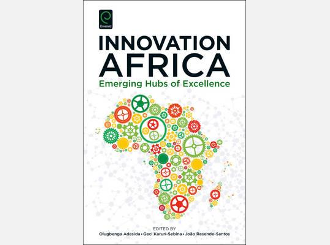
At a time when Africa has bold aspirations, through Agenda 2063, to confront large scale challenges like the ascendant demographic curve, green industrialization and domestic resource mobilization, it is imperative that innovation be inclusive in order to facilitate the creation of decent jobs, generate investments, and contribute to the continent’s structural transformation. As a late comer, Africa has the advantage to leapfrog technologies, learn from others mistakes and reinvent things differently in a way that promotes sustainability as well as inclusiveness. But to succeed, deliberate policies are badly needed.
With this backdrop, the book “Innovation Africa: Emerging Hubs of Excellence” is a must read. Authors, Olugbenga Adesida, Geci Karuri-Sebina and João Resende-Santos not only illustrate Africa’s experience with innovation to date but also point to its power for transformation. From the very onset, one is reminded that “Africa is no longer the place it was in the past … the technological innovations taking place on the continent today offer the promise of transforming African countries from trading mainly in materials and commodities to trading in knowledge-intensive products.”
The book posits that the popular “Africa rising” narrative originates from external (non-African) perspectives vis a vis what economic development and innovation systems means for the continent. By default, this perspective ignores many of the realities and opportunities that actually exist on the continent. The book however offers a refreshing alternative; a Pan-African narrative and prospective framework to address the challenges of development as well as underdevelopment to match the African context. For instance, the authors advocate for the development of inclusive innovation systems; the practice of self-reliance as opposed to dependency; and the importance for strengthened human and institutional capacity which includes the richness of the African culture and its endogenous potential.
Through a medley of nine case studies, from Nollywood’s rise to Algeria’s steel industry, sizeable innovations from hubs across different regions of the continent, are showcased. The success factors as well as lessons learned are analysed and concrete policy recommendations offered on what must be done differently going forward. It becomes clear to the reader that Africa has the ability as well as potential to innovate and that there are a multiplicity of the players driving innovation. For example, the study of Cape Verde’s successful electronic government led by public sector, illustrates how policy driven innovation has reduced the costs and time of doing business and worked-well in the context of a small island developing country. An analysis of the mobile technology innovation ecosystem in Kenya demonstrates how a combination of deliberate policies, infrastructure development as well as having the government in the lead, have been instrumental in providing the enabling institutional and macroeconomic environment needed for the innovation to thrive. The story of Ghana’s Suame Magazine illustrates how the informal sector and its artisans have been key in the emergence of one of the country’s most important industrial zones specialising in engineering and manufacturing. While a study on the Palm Residue Industry in Egypt showcases how innovation has transformed agricultural by-products into a local treasure with social and economic benefits spearheaded by the academic sector in cooperation with the private sector and local community.
A clear take away is that for innovation to mature, thrive and be valued, it must be supported by a conducive ecosystem. More must be done if Africa is to fully harness innovation systems and compete in the new world economy. In turn the book offers a menu of the deliberate policies needed in order to step up the pace of innovation in Africa, making it a treasure trove for policy makers, academics, business leaders and the public at large.
There is an exciting opportunity just around the corner to make Africa the continent of the future if we just pay attention to the messages of this book.